Pulsar Signal Adaptive Surrogate Modeling
Abstract
:1. Introduction
1.1. Physics of Pulsars
1.2. Surrogate Modeling
1.3. Pulsar Navigation and Timing
1.4. Pulsar Signal Models
- The direct method is the baseline method [53]. Using the pulse profile model , it is divided into a fixed number N of time bins with length such that with P being the pulse profile period. For each bin, the value of , is then used as the input parameter for the non-homogeneous Poisson process to generate the number of photons in this bin based on the Poisson distribution.
- The inverse mapping method is introduced in [54]. It is proven that the next photon TOA can be generated based on the current photon TOA . The advantage is that the computational time to generate the signal does not depend on its length but only on the number of generated photons.
- The statistical method from [55] eliminates the direct dependency on observation time and calculations of differential equations for each photon as required by the inverse mapping method. It proves that the probability distribution of photon TOA can be used as the pulse profile during one period. Apart from computational efficiency, the signal and noise are generated separately, allowing for precise control of both.
2. Materials and Methods
2.1. Pulsar Visibility
2.2. Pulsar Radio Flux Intensity
- Simple power-law spectrum;
- Broken power-law spectrum;
- Log parabolic spectrum;
- Power law with high-frequency cut-off;
- Power law with low-frequency turn-over.
- For pulsars with two or more measurements, evaluate the index from these measurements.
- Data from available papers are used to add or replace the spectral index and flux data with more precise values. Data from [60,70] are already part of ATNF version 2.0.1 and higher, so there is no need for a special evaluation. For [61], data are also part of ATNF, but it is possible to utilize this paper’s classification and extra information. Other references utilized in this step include [63,64].
- For each pulsar and each of its measurements, compute the total flux.
- Sort pulsars according to their total expected flux for the used radio telescope. The pulsar distribution in galactic coordinates can be seen in Figure 3 with point colors based on the method used to compute the total flux.
2.3. Observation Planning
2.4. Radio Telescope Characteristics
2.5. Pulsar Signal Model Requirements and Design
- There are much more radio telescopes on Earth than X-ray observatories in space.
- For the purpose of pulsar signal modeling, the radio telescope does not need to have the ability to observe a single pulse. This leads to the requirement of smaller sensitivity, further widening the number of radio telescopes that can be used to obtain radio signals.
- Using on-Earth telescopes with a smaller pressure for observation time leads to an increased number of possibly longer observations.
- With different PTA projects running for up to 20 years, there is a long history of possible pulsar radio signals to be used with a very long time span.
- The model should utilize radio measurements.
- The model should enable the generation of an X-ray-like signal suitable for use in simulations or HIL tests of pulsar-based navigation and timing solutions.
- The model should enable the reproduction of pulsar signals for objects with known changes in pulsar parameters, like binary pulsars or pulsars with trends in period evolution.
- The radio signal input should be 30–300 of length per single observation, based on target pulsar’s SNR.
- The frequency of radio observations should be at least once per month considering the pulsar behavior stability.
- The X-ray-like output should be generated for times with radio observations available but also between them.
- The model should enable the reproduction of pulsar signal characteristic changes relevant to expected use, mainly pulse period, intensity, and shape change.
- The model will include not only the pulsar signal but also an additional noise. The mid- and long-term evolution of the noise for each target pulsar should be modeled as well for a more realistic synthetic signal.
2.6. Pulsar Observations
2.7. Radio Telescope Signal Processing
3. Results
3.1. Pulsar Signal Parameters Interpolation
- , —list of all starts of observations; M is number of observations used [MJD].
- , —list of all initial pulse phases [1].
- , —list of all pulse periods [].
- , , —list of preprocessed intensities for all pulse bins of all observations [1], building a shape of each profile i.
3.2. Pulsar Signal Generator
3.2.1. Pulsar Signal Model
3.2.2. Model-Based Signal Generator
3.3. Pulse Detection Statistics
3.4. Surrogate Pulsar Signal Model Validation
4. Discussion
Future Trends
Author Contributions
Funding
Data Availability Statement
Conflicts of Interest
Abbreviations
| ATNF | Australia Telescope National Facility |
| CAS | Czech Academy of Science |
| DM | Dispersion Measure |
| DSN | Deep Space Network |
| ESSK | Exponential Sine Squared Kernel |
| GP | Gaussian Process |
| GPR | Gaussian Process Regression |
| GPSP | Gigahertz Peak-Spectrum Pulsar |
| GTI | Good Time Interval |
| HIL | HW-in-the-loop |
| IMU | Inertial Measurement Unit |
| ISM | Interstellar Medium |
| MJD | Modified Julian Days |
| NICER | Neutron Star Interior Composition Explorer |
| PRESTO | Pulsar Exploration and Search Toolkit |
| PTA | Pulsar Timing Array |
| RQK | Rational Quadratic Kernel |
| RFI | Radio Frequency Interference |
| SC | Spacecraft |
| SEK | Squared Exponential Kernel |
| SEXTANT | Station Explorer for X-ray Timing and Navigation Technology |
| SNR | Signal-to-Noise Ratio |
| SSB | Solar System Barycenter |
| TOA | Time of Arrival |
| XNAV | X-ray Pulsar Based Navigation |
References
- Anderson, K.; Pines, D.; Sheikh, S. Validation of Pulsar Phase Tracking for Spacecraft Navigation. J. Guid. Control Dyn. 2015, 38, 1–13. [Google Scholar] [CrossRef]
- Graven, P.; Collins, J.; Sheikh, S.; Hanson, J.; Ray, P.; Wood, K. XNAV for deep space navigation. In Proceedings of the 31st Annual AAS Guidance and Control Conference, Breckenridge, CO, USA, 1–6 February 2008. [Google Scholar]
- Sheikh, S. The Use of Variable Celestial X-ray Sources for Spacecraft Navigation. Ph.D. Thesis, University of Maryland, College Park, MD, USA, 2005. [Google Scholar]
- Smith, R.; Sheikh, S.; Swinney, R. Navigation to the Alpha Centauri star system. J. Br. Interplanet. Soc. 2017, 69, 379–389. [Google Scholar]
- Lorimer, D.R. Binary and Millisecond Pulsars. Living Rev. Relativ. 2005, 8, 7. [Google Scholar] [CrossRef] [PubMed]
- Lynch, R.S. Pulsar Timing Arrays. J. Phys. Conf. Ser. 2015, 610, 012017. [Google Scholar] [CrossRef]
- Dyks, J. Geometry of radio pulsar signals: The origin of pulsation modes and nulling. Astron. Astrophys. 2021, 653, L3. [Google Scholar] [CrossRef]
- Lorimer, D.R.; Kramer, M. Handbook of Pulsar Astronomy; Cambridge University Press: Cambridge, UK, 2012. [Google Scholar]
- Lyne, A.; Graham-Smith, F. Pulsar Astronomy, 4th ed.; Cambridge Astrophysics, Cambridge University Press: Cambridge, UK, 2022. [Google Scholar]
- Pennucci, T.T.; Possenti, A.; Esposito, P.; Rea, N.; Haggard, D.; Baganoff, F.K.; Burgay, M.; Zelati, F.C.; Israel, G.L.; Minter, A. Simultaneous Multi-band Radio and X-ray Observations of the Galactic Center Magnetar SGR 1745–2900. Astrophys. J. 2015, 808, 81. [Google Scholar] [CrossRef]
- Koziel, S.; Leifsson, L. Introduction to Surrogate Modeling and Surrogate-Based Optimization; Springer: Cham, Switzerland, 2016; pp. 31–61. [Google Scholar] [CrossRef]
- Cristianini, N.; Shawe-Taylor, J. An Introduction to Support Vector Machines and Other Kernel-Based Learning Methods; Cambridge University Press: Cambridge, UK, 2001. [Google Scholar] [CrossRef]
- Duvenaud, D. Automatic Model Construction with Gaussian Processes. Ph.D. Thesis, Cambridge University Press, Cambridge, UK, 2014. [Google Scholar] [CrossRef]
- Roberts, S.J.; Osborne, M.A.; Ebden, M.; Reece, S.; Gibson, N.P.; Aigrain, S. Gaussian processes for time-series modelling. Philos. Trans. R. Soc. A Math. Phys. Eng. Sci. 2013, 371, 20110550. [Google Scholar] [CrossRef]
- de Visser, C. Global Nonlinear Model Identification with Multivariate Splines. Ph.D. Thesis, Delft University of Technology, Delft, The Netherlands, 2011. [Google Scholar]
- Rasmussen, C.E.; Williams, C.K.I. Gaussian Processes for Machine Learning; The MIT Press: Cambridge, MA, USA, 2005. [Google Scholar] [CrossRef]
- Queipo, N.V.; Haftka, R.T.; Shyy, W.; Goel, T.; Vaidyanathan, R.; Kevin Tucker, P. Surrogate-based analysis and optimization. Prog. Aerosp. Sci. 2005, 41, 1–28. [Google Scholar] [CrossRef]
- Schreiber, T.; Schmitz, A. Surrogate time series. Phys. D Nonlinear Phenom. 2000, 142, 346–382. [Google Scholar] [CrossRef]
- Wang, Y.; Wang, Y.; Zheng, W. A Gaussian Process Surrogate Model Assisted Multi-optimization Algorithm for Pulsar Period Searching. In Proceedings of the China Satellite Navigation Conference (CSNC 2024) Proceedings, Jinan, China, 22–24 May 2024; Yang, C., Xie, J., Eds.; Springer Nature: Singapore, 2024; pp. 320–330. [Google Scholar]
- Batrakov, A.; Hu, H.; Wex, N.; Freire, P.; Venkatraman Krishnan, V.; Kramer, M.; Guo, Y.; Guillemot, L.; McKee, J.; Cognard, I.; et al. A new pulsar timing model for scalar-tensor gravity with applications to PSR J2222-0137 and pulsar-black hole binaries. Astron. Astrophys. 2023, 686, A101. [Google Scholar] [CrossRef]
- Kedia, A.; Ristic, M.; O’Shaughnessy, R.; Yelikar, A.B.; Wollaeger, R.T.; Korobkin, O.; Chase, E.A.; Fryer, C.L.; Fontes, C.J. Surrogate light curve models for kilonovae with comprehensive wind ejecta outflows and parameter estimation for AT2017gfo. Phys. Rev. Res. 2023, 5, 013168. [Google Scholar] [CrossRef]
- Alizadeh, R.; Allen, J.K.; Mistree, F. Managing computational complexity using surrogate models: A critical review. Res. Eng. Des. 2020, 31, 275–298. [Google Scholar] [CrossRef]
- Ben Salem, M.; Tomaso, L. Automatic selection for general surrogate models. Struct. Multidiscip. Optim. 2018, 58, 719–734. [Google Scholar] [CrossRef]
- Garud, S.S.; Karimi, I.; Kraft, M. Smart Sampling Algorithm for Surrogate Model Development. Comput. Chem. Eng. 2017, 96, 103–114. [Google Scholar] [CrossRef]
- Huang, T.; Liu, Y.; Pan, Z. Deep Residual Surrogate Model. Inf. Sci. 2022, 605, 86–98. [Google Scholar] [CrossRef]
- Xu, Y.; Renteria, A.; Wang, P. Adaptive surrogate models with partially observed information. Reliab. Eng. Syst. Saf. 2022, 225, 108566. [Google Scholar] [CrossRef]
- Zhang, J.; Chowdhury, S.; Messac, A. An adaptive hybrid surrogate model. Struct. Multidiscip. Optim. 2012, 46, 223–238. [Google Scholar] [CrossRef]
- Kocijan, J. Modelling and Control of Dynamic Systems Using Gaussian Process Models; Springer: Cham, Switzerland, 2016. [Google Scholar] [CrossRef]
- Wang, J. An Intuitive Tutorial to Gaussian Process Regression. Comput. Sci. Eng. 2023, 25, 4–11. [Google Scholar] [CrossRef]
- Williams, B.; Cremaschi, S. Selection of surrogate modeling techniques for surface approximation and surrogate-based optimization. Chem. Eng. Res. Des. 2021, 170, 76–89. [Google Scholar] [CrossRef]
- Gutmann, H.M. A Radial Basis Function Method for Global Optimization. J. Glob. Optim. 2001, 19, 201–227. [Google Scholar] [CrossRef]
- Lawrence, N.; Seeger, M.; Herbrich, R. Fast Sparse Gaussian Process Methods: The Informative Vector Machine. Adv. Neural Inf. Process. Syst. 2002, 15, 625–632. [Google Scholar]
- Wang, Y.; Zheng, W.; Zhang, S.; Ge, M.; Li, L.; Jiang, K.; Chen, X.; Zhang, X.; Zheng, S.; Lu, F. Review of X-ray pulsar spacecraft autonomous navigation. Chin. J. Aeronaut. 2023, 36, 44–63. [Google Scholar] [CrossRef]
- Han, W.; Wang, N.; Wang, J.; Yuan, J.; He, D. Using single millisecond pulsar for terrestrial position determination. Astrophys. Space Sci. 2019, 364, 48. [Google Scholar] [CrossRef]
- Buist, P.J.; Engelen, S.; Noroozi, A.; Sundaramoorthy, P.; Verhagen, S.; Verhoeven, C. Overview of Pulsar Navigation: Past, Present and Future Trends. Navigation 2011, 58, 153–164. [Google Scholar] [CrossRef]
- Emadzadeh, A.A.; Speyer, J. Navigation in Space by X-ray Pulsars; Springer: Berlin/Heidelberg, Germany, 2011. [Google Scholar]
- Shen, L.R.; Li, X.P.; Sun, H.F.; Fang, H.Y.; Xue, M.F. A novel period estimation method for X-ray pulsars based on frequency subdivision. Front. Inf. Technol. Electron. Eng. 2015, 16, 858–870. [Google Scholar] [CrossRef]
- Liu, J.; Yang, Z.-H.; Kang, Z.-W.; Chen, X. Fast CS-based pulsar period estimation method without tentative epoch folding and its CRLB. Acta Astronaut. 2019, 160, 90–100. [Google Scholar] [CrossRef]
- Cassanelli, T.; Naletto, G.; Codogno, G.; Barbieri, C.; Verroi, E.; Zampieri, L. New technique for determining a pulsar period: Waterfall principal component analysis. Astron. Astrophys. 2022, 663, A106. [Google Scholar] [CrossRef]
- Ma, X.; Xie, T.; Li, J.; Zhang, W.; Cheng, Y.; Cui, P.; Ning, X. An energy-based pulsar period estimation method using Hilbert curve and double CNNs. Acta Astronaut. 2024, 219, 79–90. [Google Scholar] [CrossRef]
- Xie, T.H.; Ma, X.; Zhang, W.J.; Li, J.R.; Wang, S.T.; Yang, Z.N.; Cui, P.L.; Ning, X.L.; Fang, J.C. Dynamic estimation method for pulsar periods based on photon energy distribution folding and image template matching. Astron. Astrophys. 2024, 686, A214. [Google Scholar] [CrossRef]
- Wei, Z.; Yidi, W. X-ray Pulsar-Based Navigation: Theory and Applications; Springer: Berlin/Heidelberg, Germany, 2020. [Google Scholar]
- Zhou, Q.; Liu, S.; Hao, X.; Jiang, K. A Relativistic Model of X-Ray Pulsar Signal for Navigation. In Proceedings of the China Satellite Navigation Conference (CSNC 2022) Proceedings, Beijing, China, 25–27 May 2022; Yang, C., Xie, J., Eds.; Springer Nature: Singapore, 2022; pp. 433–441. [Google Scholar]
- Sala, J.; Urruela, A.; Villares, X.; Estalella, R.; Paredes, J.M. Feasibility Study for a Spacecraft Navigation System Relying on Pulsar Timing Information (Final Report); Adv Res Team of ESA 1-90. Technical Report; ESA Advanced Concepts Team: Noordwijk, The Netherlands, 2004. [Google Scholar]
- Sheikh, S.I.; Hanson, J.E.; Collins, J.; Graven, P. Deep Space Navigation Augmentation Using Variable Celestial X-ray Sources. Proc. Inst. Navig. Natl. Tech. Meet. 2009, 1, 34–48. [Google Scholar]
- Zhang, X.; Shuai, P.; Huang, L.; Chen, S.; Xu, L. Mission Overview and Initial Observation Results of the X-ray Pulsar Navigation-I Satellite. Int. J. Aerosp. Eng. 2017, 2017, 8561830. [Google Scholar] [CrossRef]
- Mitchell, J.W.; Hassouneh, M.; Winternitz, L.; Valdez, J.; Price, S.; Semper, S.R.; Yu, W.H.; Arzoumanian, Z.; Ray, P.; Wood, K.S.; et al. SEXTANT—Station Explorer for X-ray Timing and Navigation Technology. In Proceedings of the AIAA Guidance, Navigation, and Control Conference, Kissimmee, FL, USA, 5–9 January 2015. [Google Scholar] [CrossRef]
- NASA. Catalogs and astronomical archives of the HEASARC. Available online: https://heasarc.gsfc.nasa.gov/docs/archive.html (accessed on 6 October 2024).
- Lohan, K.G.; Putnam, Z.R. Characterization of Candidate Solutions for X-Ray Pulsar Navigation. IEEE Trans. Aerosp. Electron. Syst. 2024, 60, 2749–2762. [Google Scholar] [CrossRef]
- Shemar, S.; Fraser, G.; Heil, L.; Hindley, D.; Martindale, A.; Molyneux, P.; Pye, J.; Warwick, R. Towards practical autonomous deep-space navigation using X-ray pulsar timing. Exp. Astron. 2016, 42, 101–138. [Google Scholar] [CrossRef]
- Ren, X.; Nie, G.; Li, L. An Improved Augmented Algorithm for Direction Error in XPNAV. Symmetry 2020, 12, 1059. [Google Scholar] [CrossRef]
- Xu, Q.; Wang, H.-L.; Feng, L.; You, S.-H.; He, Y.-Y. A novel X-ray pulsar integrated navigation method for ballistic aircraft. Optik 2018, 175, 28–38. [Google Scholar] [CrossRef]
- Fu, L.; Shuai, P.; Xue, M.; Sun, H.; Fang, H. The Research of X-Ray Pulsar Signals Simulation Method. In Proceedings of the China Satellite Navigation Conference (CSNC) 2015 Proceedings, Xi’an, China, 13–15 May 2015; Sun, J., Liu, J., Fan, S., Lu, X., Eds.; Springer: Berlin/Heidelberg, Germany, 2015; Volume III, pp. 635–647. [Google Scholar]
- Emadzadeh, A.A.; Speyer, J.L. On Modeling and Pulse Phase Estimation of X-ray Pulsars. IEEE Trans. Signal Process. 2010, 58, 4484–4495. [Google Scholar] [CrossRef]
- Zhang, H.; Xu, L.; Song, S.; Jiao, R. A fast method for X-ray pulsar signal simulation. Acta Astronaut. 2014, 98, 189–200. [Google Scholar] [CrossRef]
- Jin, J.; Liu, Y.; Li, X.; Shen, Y.; Huang, L. A simulation method for X-ray pulsar signal based on Monte Carlo. In Proceedings of the 2016 IEEE International Conference on Mechatronics and Automation, Harbin, China, 7–10 August 2016; pp. 1937–1942. [Google Scholar] [CrossRef]
- Huang, Z.; Zong, H.; Xie, Y.; Yu, D.; Xu, Q.; Lu, K. X-ray pulsar observation signals simulation method at the spacecraft in near-Earth space. Adv. Space Res. 2024, 73, 6241–6254. [Google Scholar] [CrossRef]
- Su, J.; Fang, H.; Bao, W.; Sun, H.; Shen, L.; Zhao, L. Fast simulation of X-ray pulsar signals at a spacecraft. Acta Astronaut. 2020, 166, 93–103. [Google Scholar] [CrossRef]
- Green, R.M. Spherical Astronomy; Cambridge University Press: Cambridge, UK, 1985; p. 546. [Google Scholar]
- Bilous, A.V.; Kondratiev, V.I.; Kramer, M.; Keane, E.F.; Hessels, J.W.T.; Stappers, B.W.; Malofeev, V.M.; Sobey, C.; Breton, R.P.; Cooper, S.; et al. A LOFAR census of non-recycled pulsars: Average profiles, dispersion measures, flux densities, and spectra. Astron. Astrophys. 2016, 591, A134. [Google Scholar] [CrossRef]
- Jankowski, F.; van Straten, W.; Keane, E.F.; Bailes, M.; Barr, E.D.; Johnston, S.; Kerr, M. Spectral properties of 441 radio pulsars. Mon. Not. R. Astron. Soc. 2018, 473, 4436–4458. [Google Scholar] [CrossRef]
- Kijak, J.; Basu, R.; Lewandowski, W.; Rożko, K.; Dembska, M. Gigahertz-peaked Spectra Pulsars and Thermal Absorption Model. Astrophys. J. 2017, 840, 108. [Google Scholar] [CrossRef]
- Kijak, J.; Lewandowski, W.; Maron, O.; Gupta, Y.; Jessner, A. Pulsars with gigahertz-peaked spectra. Astron. Astrophys. 2011, 531, A16. [Google Scholar] [CrossRef]
- Rożko, K.; Basu, R.; Kijak, J.; Lewandowski, W. The uGMRT Observations of Three New Gigahertz-peaked Spectra Pulsars. Astrophys. J. 2021, 922, 125. [Google Scholar] [CrossRef]
- Armstrong, J.W.; Rickett, B.J.; Spangler, S.R. Electron Density Power Spectrum in the Local Interstellar Medium. Astrophys. J. 1995, 443, 209. [Google Scholar] [CrossRef]
- Bhat, N.; Rao, A.; Gupta, Y. Long-Term Scintillation Studies of Pulsars: I. Observations and Basic Results. Astrophys. J. Suppl. 1999, 121, 483. [Google Scholar] [CrossRef]
- Stinebring, D.R.; Smirnova, T.V.; Hankins, T.H.; Hovis, J.S.; Kaspi, V.M.; Kempner, J.C.; Myers, E.; Nice, D.J. Five Years of Pulsar Flux Density Monitoring: Refractive Scintillation and the Interstellar Medium. Astrophys. J. 2000, 539, 300. [Google Scholar] [CrossRef]
- Puricer, P.; Kovář, P.; Barta, M. Modernized Solar Radio Spectrograph in the L Band Based on Software Defined Radio. Electronics 2019, 8, 861. [Google Scholar] [CrossRef]
- Bates, S.D.; Lorimer, D.R.; Verbiest, J.P.W. The pulsar spectral index distribution. Mon. Not. R. Astron. Soc. 2013, 431, 1352–1358. [Google Scholar] [CrossRef]
- Cameron, A.D.; Li, D.; Hobbs, G.; Zhang, L.; Miao, C.C.; Wang, J.B.; Yuan, M.; Wang, S.; Jacobs Corban, G.; Cruces, M.; et al. An in-depth investigation of 11 pulsars discovered by FAST. Mon. Not. R. Astron. Soc. 2020, 495, 3515–3530. [Google Scholar] [CrossRef]
- Lorimer, D. SIGPROC: Pulsar Signal Processing Programs; Astrophysics Source Code Library, record ascl:1107.016; Michigan Technological University: Houghton, MI, USA, 2011. [Google Scholar]
- Ransom, S. PRESTO: PulsaR Exploration and Search TOolkit; Astrophysics Source Code Library, record ascl:1107.017; Michigan Technological University: Houghton, MI, USA, 2011. [Google Scholar]
- Gügercinoğlu, E.; Köksal, E.; Güver, T. On the peculiar rotational evolution of PSR B0950+08. Mon. Not. R. Astron. Soc. 2022, 518, 5734–5740. [Google Scholar] [CrossRef]
- Taylor, J.H.; Manchester, R.N.; Lyne, A.G. Catalog of 558 Pulsars. Astrophys. J. Suppl. 1993, 88, 529. [Google Scholar] [CrossRef]
- Wang, Z.; Lu, J.; Jiang, J.; Lin, J.; Lee, K.; Liang, E.; Xu, R. The radio signal of PSR B0950+08 is detected over the whole pulse phase. Mon. Not. R. Astron. Soc. 2022, 517, 5560–5568. [Google Scholar] [CrossRef]
- Gregory, R.D. Classical Mechanics; Cambridge University Press: Cambridge, UK, 2006. [Google Scholar] [CrossRef]
- Kramer, M. Geometrical analysis of average pulsar profiles using multi-component Gaussian FITS at several frequencies. II. Individual results. Astron. Astrophys. Suppl. 1994, 107, 527–539. [Google Scholar]
- Zhang, H.; Xu, L.P.; Xie, Q.; Luo, N. X-ray pulsar weak signal detection based on Bayesian estimation. Wuli Xuebao/Acta Phys. Sin. 2011, 60. [Google Scholar] [CrossRef]
- Hazboun, J.; Shapiro-Albert, B.; Baker, P.; Henkel, A.; Wagner, C.; Hesse, J.; Brook, P.; Lam, M.; McLaughlin, M.; Garver-Daniels, N. The Pulsar Signal Simulator: A Python package for simulating radio signal data from pulsars. J. Open Source Softw. 2021, 6, 2757. [Google Scholar] [CrossRef]
- Leahy, D.A.; Darbro, W.; Elsner, R.F.; Weisskopf, M.C.; Sutherland, P.G.; Kahn, S.; Grindlay, J.E. On searches for pulsed emission with application to four globular cluster X-ray sources: NGC 1851, 6441, 6624 and 6712. Astrophys. J. 1983, 266, 160–170. [Google Scholar] [CrossRef]
- Fang, H.; Sun, X.; Yao, Y.; Li, L.; Su, J.; Zhang, L. Analysis on numerical mutation in cost function of Chi-square test for frequency search of Crab pulsar. Digit. Signal Process. 2022, 129, 103688. [Google Scholar] [CrossRef]
- Xu, N.; Sheng, L.; Chen, C.; Li, Y.; Su, T.; Zhao, B.; Zheng, W.; Liu, C. Application of Gaussian fitting to the fast search of pulsar periodic. Optik 2019, 198, 163253. [Google Scholar] [CrossRef]
- Lynch, R. Searching for and Identifying Pulsars; Technical report; Department of Astronomy, University of Virginia: Charlottesville, VA, USA, 2008. [Google Scholar]

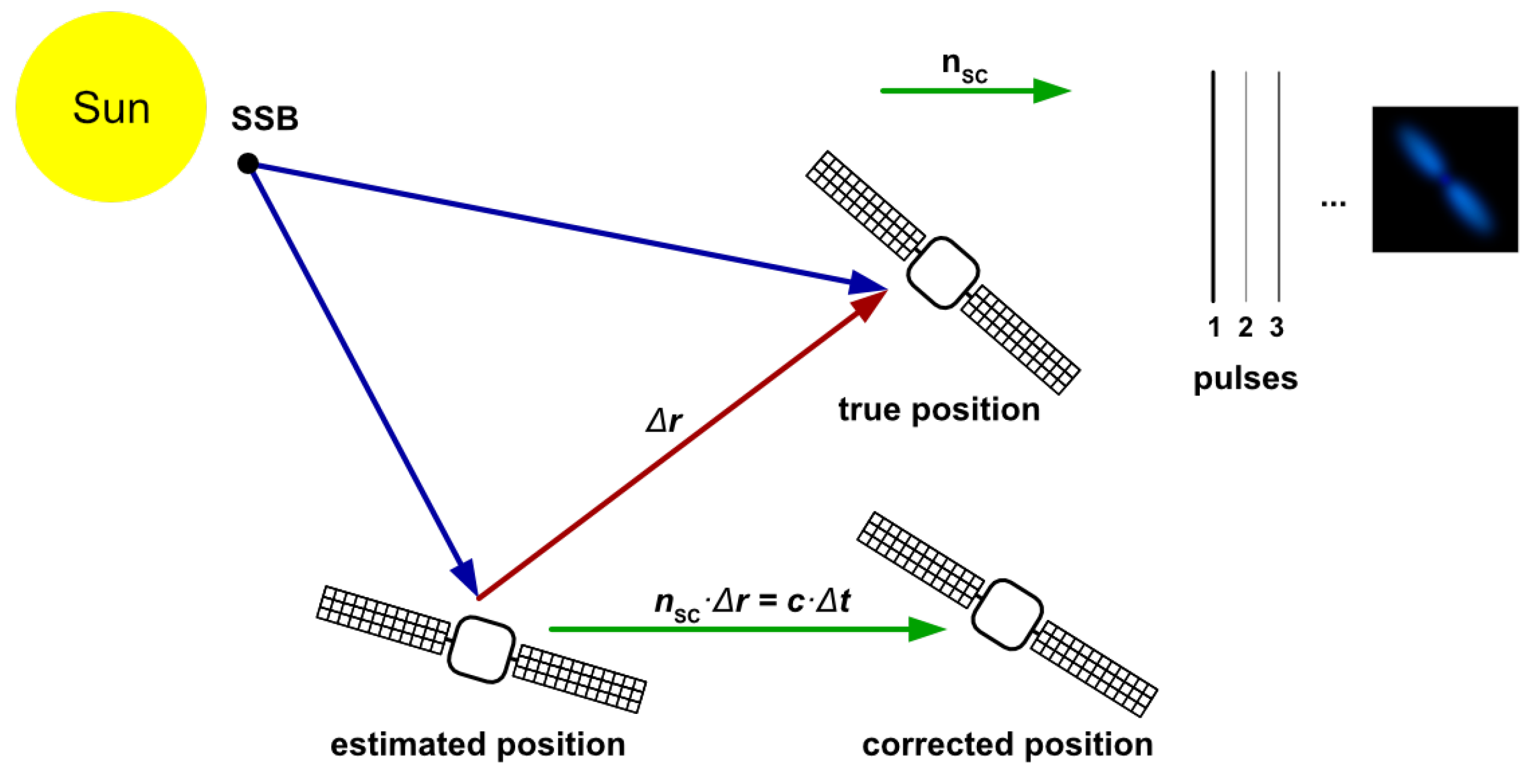
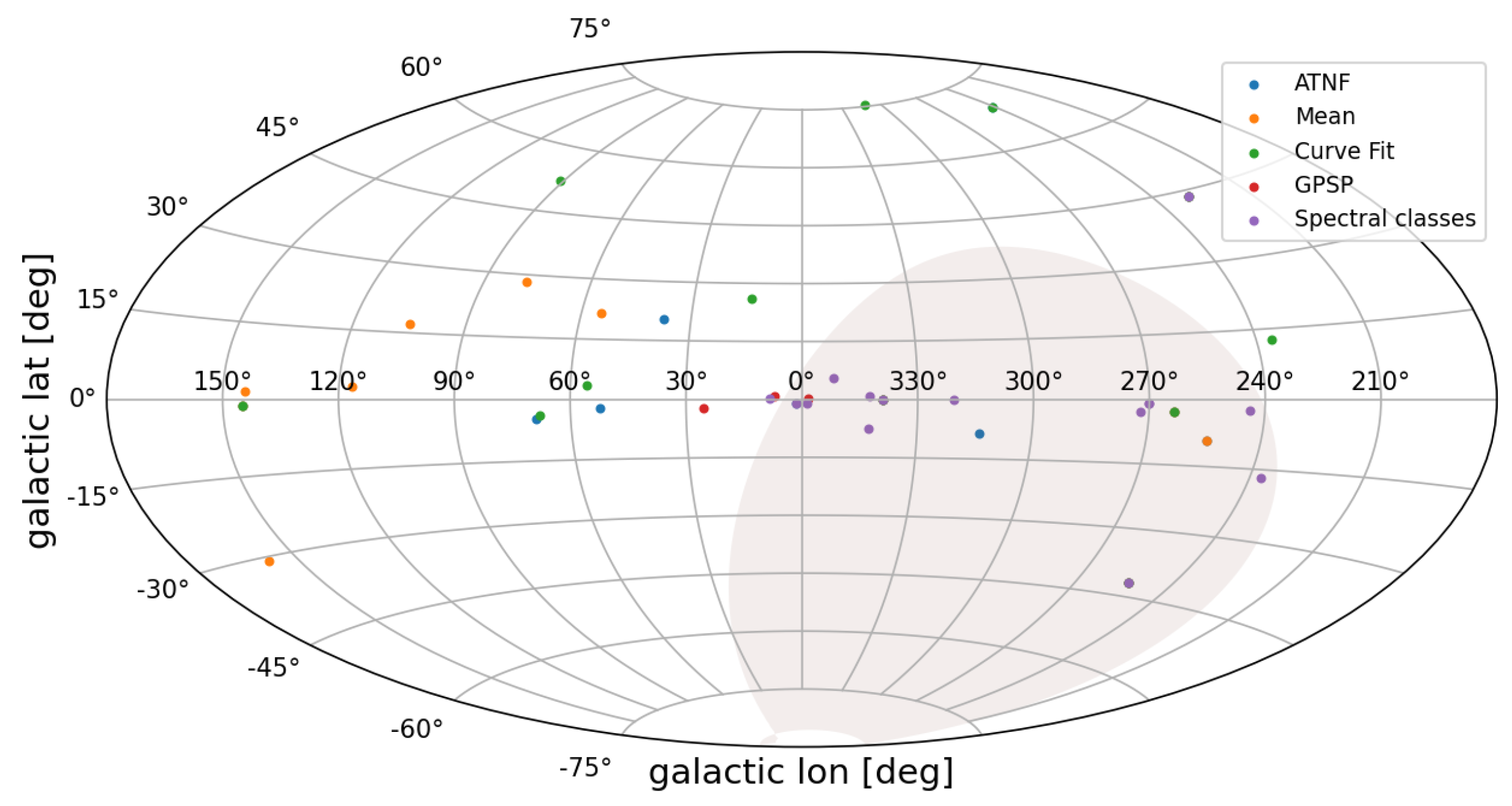
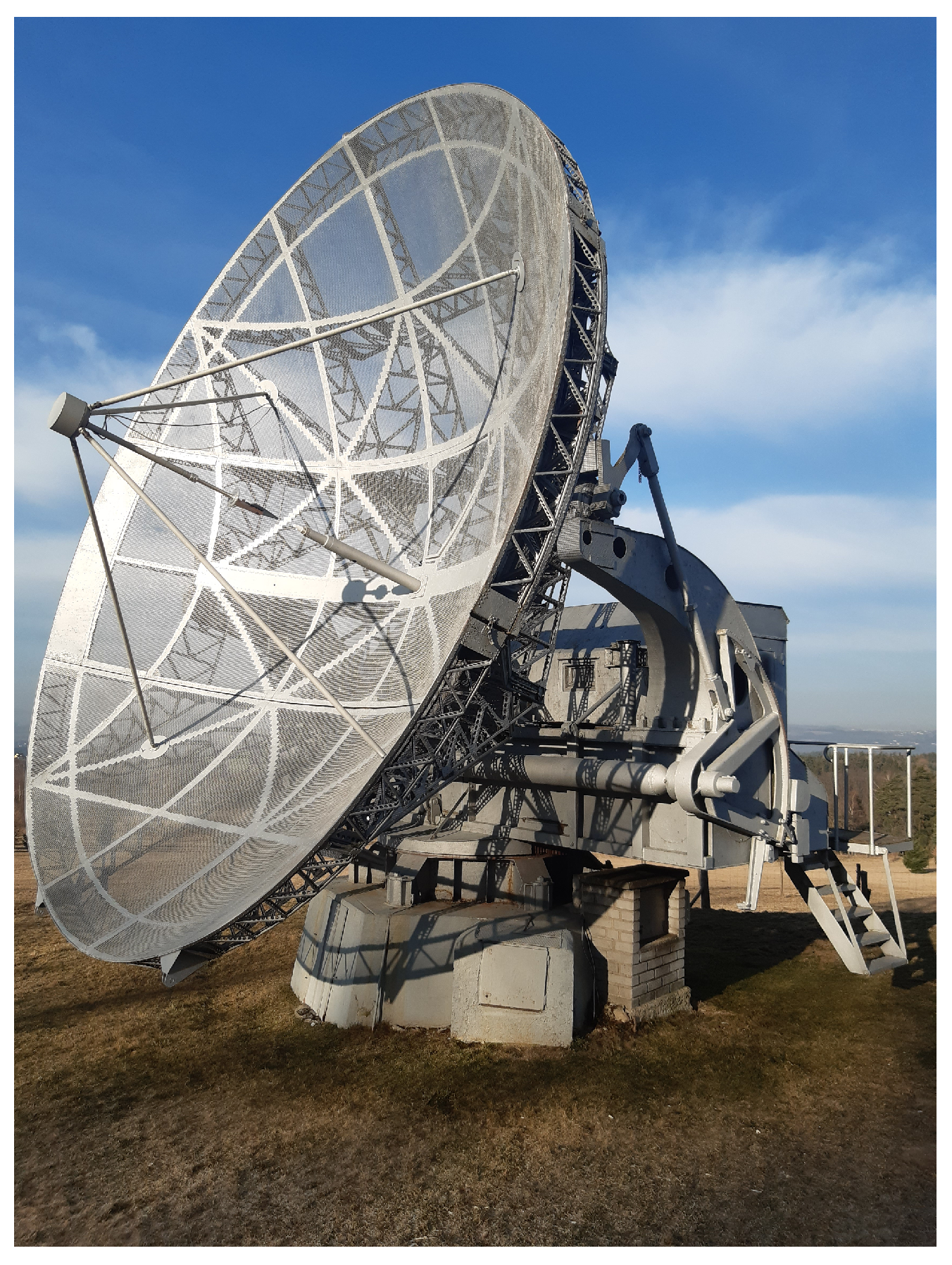

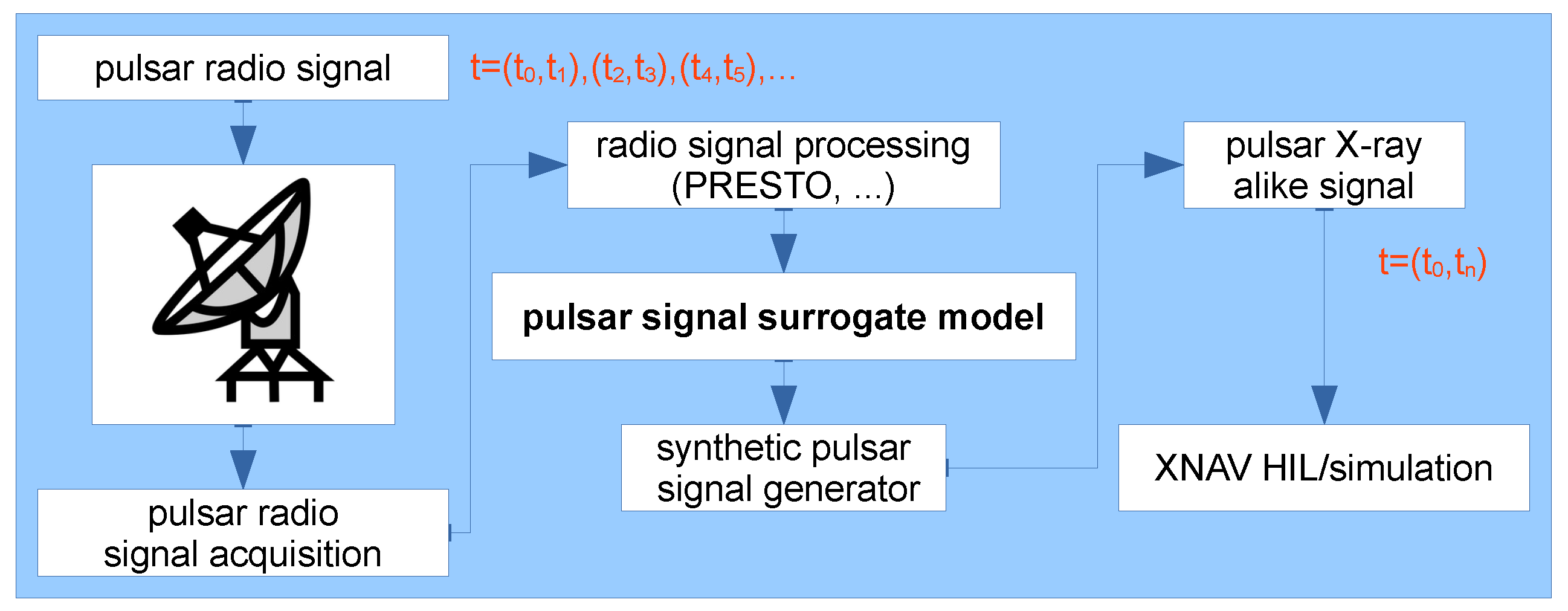
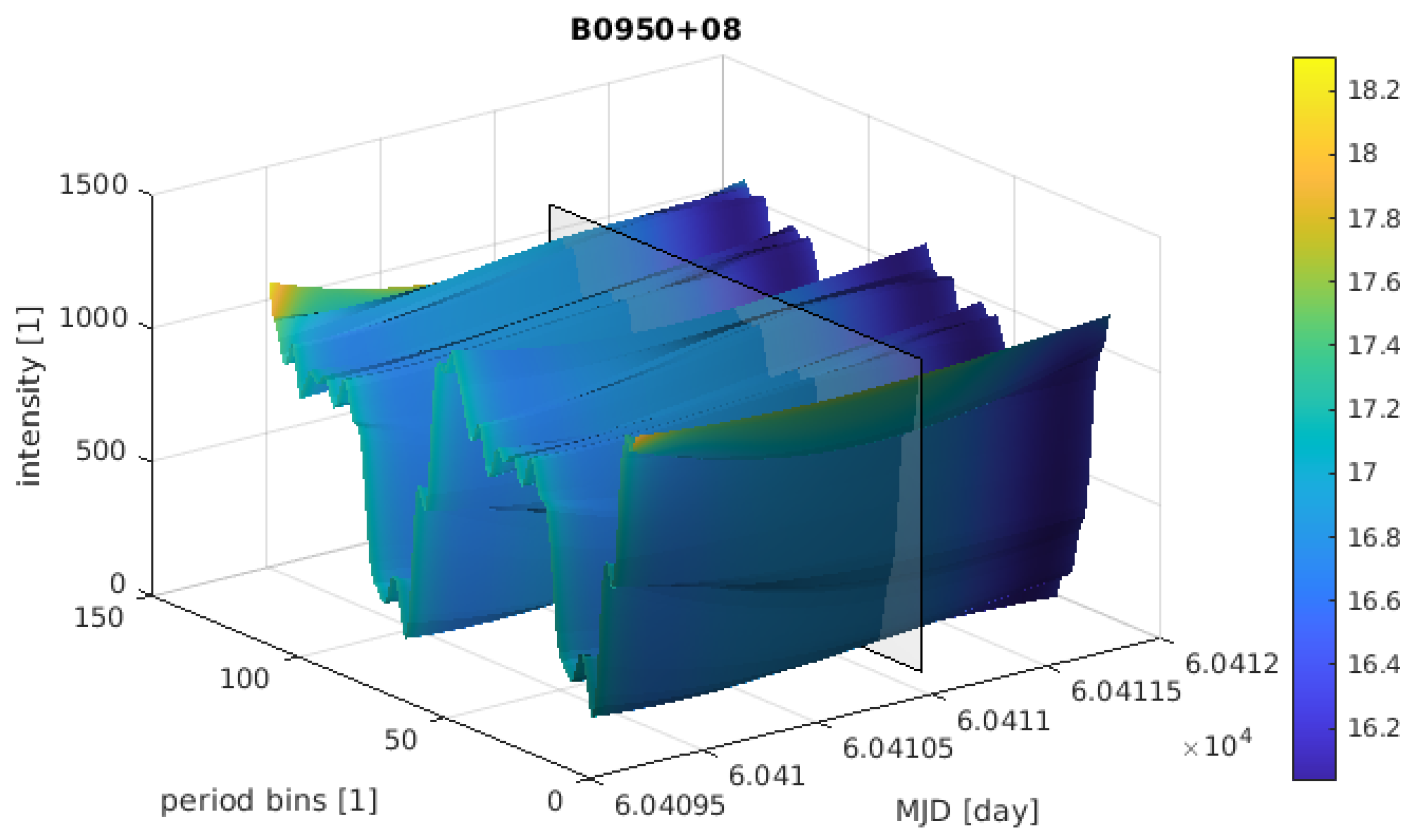
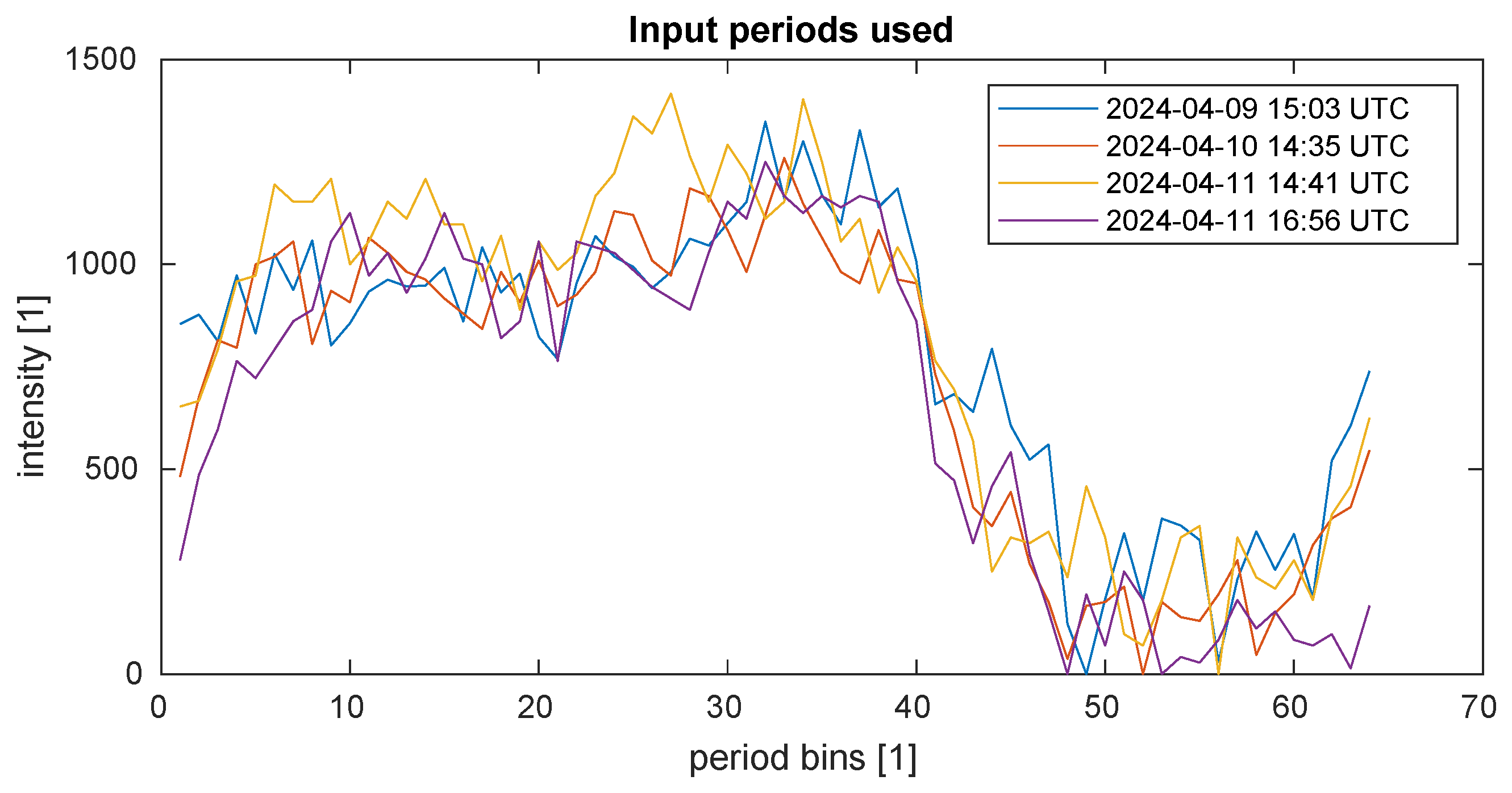

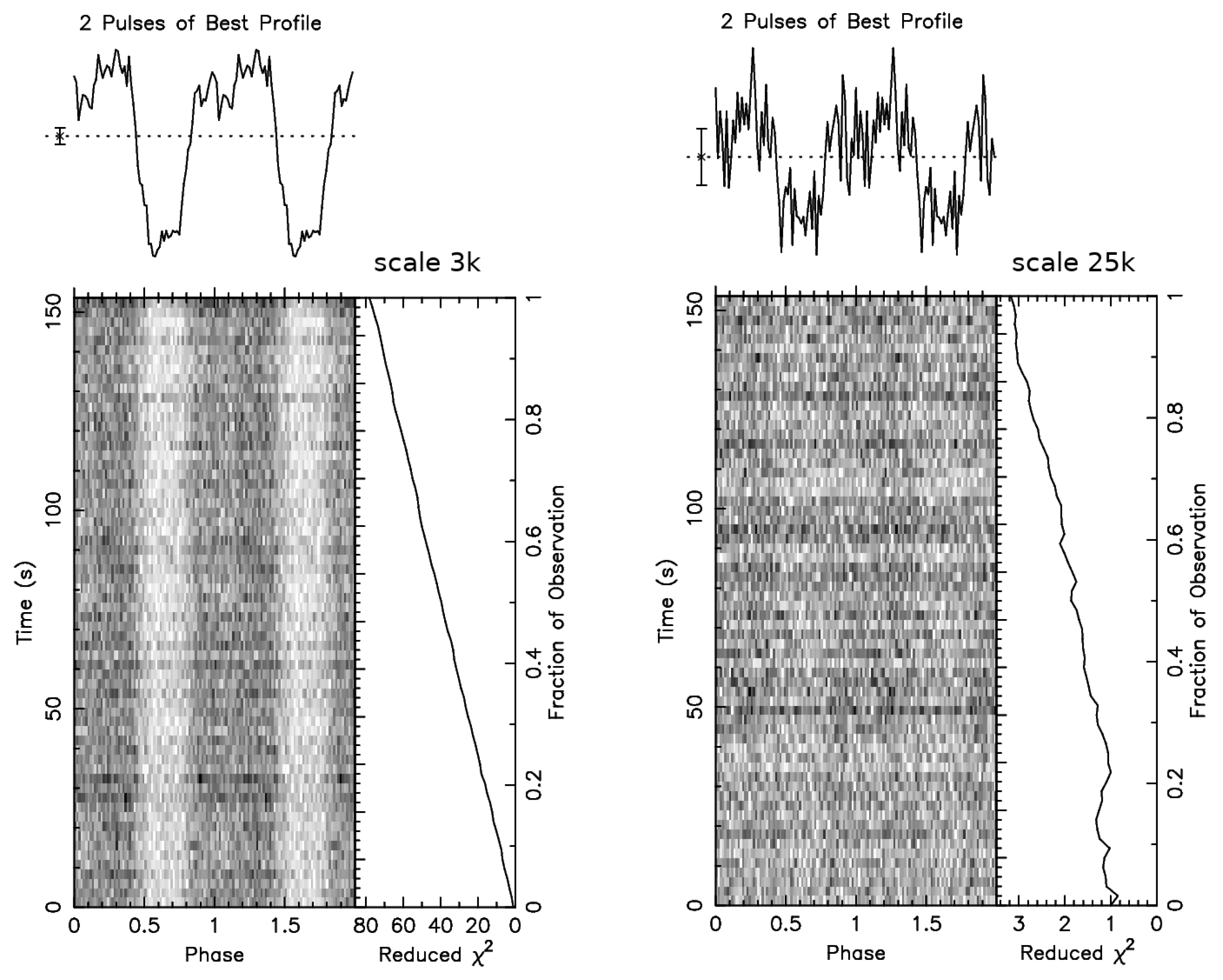

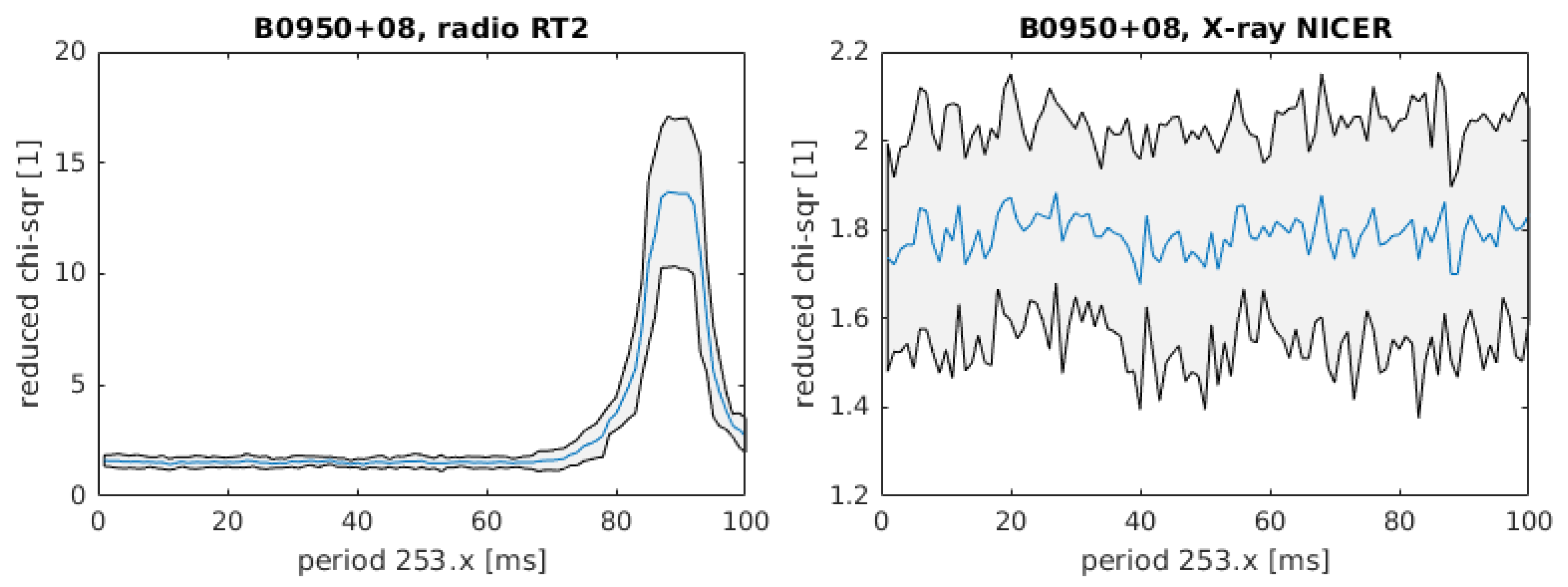





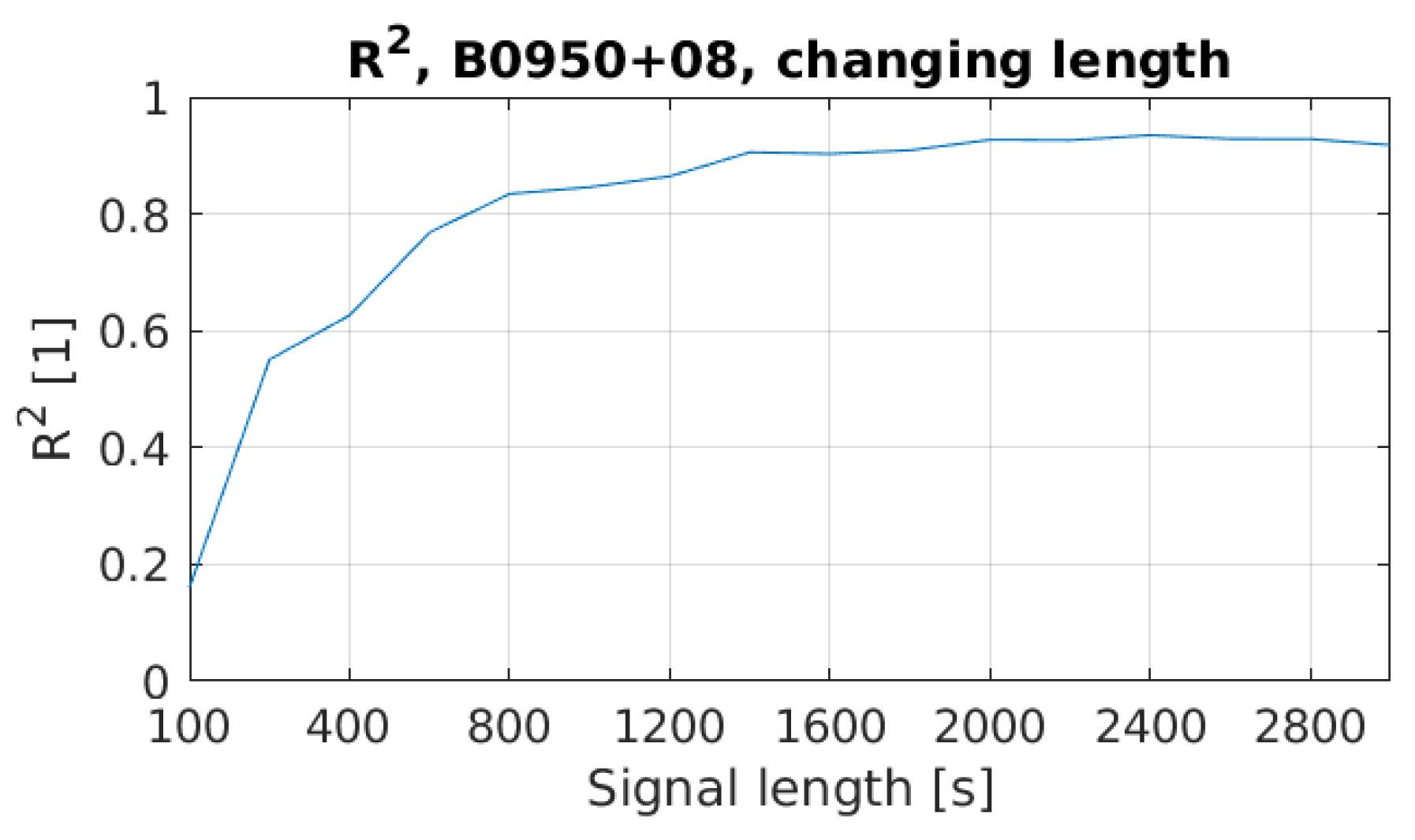

| Pulsar | P [s] | Flux [W/m2] | Fl. err [W/m2] | Vis [h] | Close to Sun |
|---|---|---|---|---|---|
| J0341+5711 | all | – | |||
| J2043+7045 | all | – | |||
| J0302+2252 | ∼12 h | 2024-04-20–05-29 | |||
| B0818-13 | ∼ 6 h | – | |||
| J2352+65 | all | – | |||
| B1642-03 | ∼ 8 h | 2024-11-25–12-08 | |||
| B2016+28 | ∼14 h | – | |||
| B1257+12 | ∼11 h | 2024-09-22–10-10 | |||
| B0329+54 | ∼22 h | – | |||
| B0950+08 | ∼10 h | 2024-09-09–08-01 |
| parabolic reflector, diameter | |
| bearing pointing accuracy | |
| half power beam width | to |
| frequency range | 1.0 to 2.0 |
| 4 sub-bands with 250 each | SP1, SP2, SP3, SP4 |
| spectral channels per sub-band | 1024 |
| frequency spectral resolution | 303 |
| time resolution | 1 |
| dynamic range | 50 |
| ADC resolution | |
| mechanical limits for antenna | elevation: to , azimuth: to |
| Kernel | Marginal Likelihood [1] |
|---|---|
| SEK | |
| Matérn kernel | |
| RQK |
Disclaimer/Publisher’s Note: The statements, opinions and data contained in all publications are solely those of the individual author(s) and contributor(s) and not of MDPI and/or the editor(s). MDPI and/or the editor(s) disclaim responsibility for any injury to people or property resulting from any ideas, methods, instructions or products referred to in the content. |
© 2024 by the authors. Licensee MDPI, Basel, Switzerland. This article is an open access article distributed under the terms and conditions of the Creative Commons Attribution (CC BY) license (https://creativecommons.org/licenses/by/4.0/).
Share and Cite
Kašpárek, T.; Chudý, P. Pulsar Signal Adaptive Surrogate Modeling. Aerospace 2024, 11, 839. https://doi.org/10.3390/aerospace11100839
Kašpárek T, Chudý P. Pulsar Signal Adaptive Surrogate Modeling. Aerospace. 2024; 11(10):839. https://doi.org/10.3390/aerospace11100839
Chicago/Turabian StyleKašpárek, Tomáš, and Peter Chudý. 2024. "Pulsar Signal Adaptive Surrogate Modeling" Aerospace 11, no. 10: 839. https://doi.org/10.3390/aerospace11100839
APA StyleKašpárek, T., & Chudý, P. (2024). Pulsar Signal Adaptive Surrogate Modeling. Aerospace, 11(10), 839. https://doi.org/10.3390/aerospace11100839






